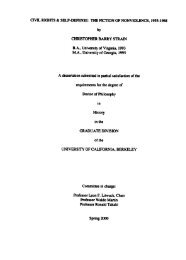Negro Digest - Freedom Archives
Negro Digest - Freedom Archives
Negro Digest - Freedom Archives
Create successful ePaper yourself
Turn your PDF publications into a flip-book with our unique Google optimized e-Paper software.
ante is formidable is obvious to<br />
anyone who reads the newspapers .<br />
That the change will come is equally<br />
obvious to all but the blind and<br />
the deaf, who really have no business<br />
at all in the crucial task of educating<br />
this new black generation<br />
who well may be our last hope for<br />
sanity and decency in this country .<br />
Some of the changes I speak of<br />
may occur through the following<br />
structures : 1 . Regional organization<br />
; 2 . Shared resources ; 3 . Systematic<br />
and continual faculty and<br />
student exchange, and 4 . Black<br />
humanists and "Specialists in<br />
Blackness .<br />
By regional organization, I mean<br />
several things . The first is the establishment<br />
of honest and creative<br />
relationships with non-academic<br />
black intellectual communities . I<br />
mean the establishment of new and<br />
respectable relationships with the<br />
black non-intellectual communities<br />
. I mean the establishment of<br />
genuine lines of communication between<br />
academic institutions in the<br />
same region, that is, exchange below<br />
the administrative level . This<br />
type of organization is admittedly<br />
difficult, but models do exist . The<br />
Atlanta University center is moving<br />
in this direction .<br />
From this type of regional reorganization<br />
could come more concrete<br />
objectives, shared resources,<br />
both general and human . Let us<br />
NEGRO DIGEST March 1968<br />
take an example of each . First, the<br />
general . By this I mean non-human<br />
resources such as library holdings,<br />
art collections, and the like . I submit<br />
that the average black student<br />
has no real notion of the richness<br />
of the Fisk <strong>Negro</strong>ana collection, or<br />
the Howard library, or the Atlanta<br />
University <strong>Negro</strong> collections of<br />
books, manuscripts, and paintings .<br />
Fewer students still know anything<br />
of the Schomberg Collection, and<br />
honesty compels me to say that altogether<br />
too few professors know<br />
very much about these collections .<br />
Whose fault is it? Our own . But<br />
fortunately, structures already exist<br />
which could make it possible for<br />
even the smallest, the poorest,<br />
<strong>Negro</strong> college to will itself to a saving<br />
state of blackness, as I have<br />
suggested its contours above .<br />
If a panel of artists and critics<br />
comparable to the one which set<br />
up the recent exhibit of Afro-<br />
American painting at City College<br />
(New York) could cull the best<br />
and the most representative examples<br />
of African and Afro-American<br />
art which our colleges possess, it<br />
should be a relatively simple matter<br />
to make slides and reproductions<br />
available at a nominal fee<br />
even to these colleges . Both, it<br />
seems to me, lie within the possibility<br />
of a Title III grant . Manuscript<br />
material and other comparatively<br />
rare items could be made available<br />
on microfilm, with provisions made<br />
for print-outs . This is just an obvious<br />
example. A more thorough<br />
going proposition would be the es-<br />
25
















